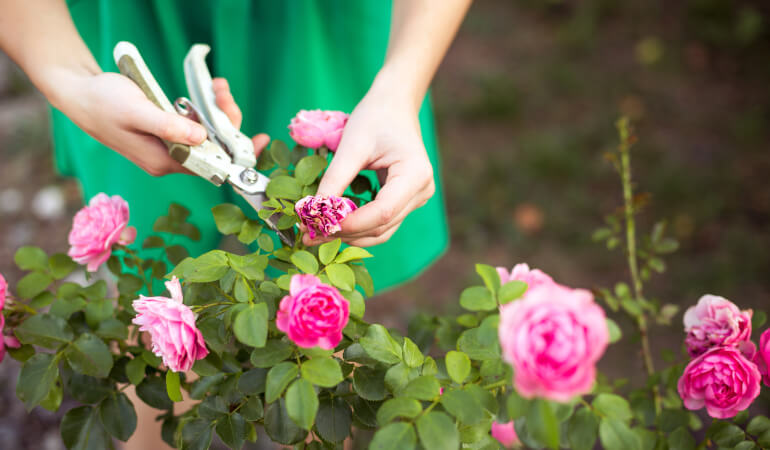
In UK gardens, roses are always a favourite. They’re bold, bright, and smell amazing; no wonder so many people plant them year after year.
But to keep roses looking their best, you need to not only feed them, but also prune them. It is very important for their health, growth and spreading. Skip pruning, and your roses will get leggy, messy, and full of dead wood.
In this post, you will learn when to prune roses and other important stuff of this sort. But first, let’s answer one essential question…
Table of Contents
Does the rose type and age matter for pruning?
Yes, it does. Both factors do. Some rose types need a hard cut, others just a light trim. That’s why you must know what kind of rose you have before you reach for the secateurs. You will learn more about the main types a bit later.
Age matters too. Let’s say you have really young plants. How, if at all, do you prune 1-year-old roses? The answer is only a little. Young roses are still getting settled. A light prune helps shape them, but too much can slow them down.
Older plants are a different story. They often get thick, woody stems and fewer flowers. Then, what to do with old woody roses? It’s called rejuvenation pruning. That means to cut out about a third of the oldest wood over a couple of years. It helps bring the rose back to life.
When is the best time to cut back roses in the UK?
The best time to prune most roses in the UK is late winter to early spring. Within this window of time, they are still dormant but about to start growing. If you want to be more specific about what month to prune roses, stick within the period between February and March. By then, the worst of the frost is usually over, and new growth is just about to start. That’s when your cuts help the plant wake up strong.
You can also do light pruning in summer. The point is simply to refine the shape. And don’t forget to deadhead. That’s when you snap off faded blooms; it keeps the plant neat and can spark more flowers.
Now you know the best pruning time, but when is it too late to prune roses? If you’re well into spring and the buds are already open, it’s best to leave it. If you cut too late you might shock the plant.
On the other hand, what happens if you prune roses too early? You risk frost damage. Early cuts can wake the plant too soon, and then a cold snap might kill the new growth. But, how cold is too cold for cut roses? If the temperatures are still dropping below zero, it’s too cold to prune. Wait until the frost eases up.
In a nutshell, look for these signs which will tell you when it’s time to cut back your roses:
- Tiny buds are starting to swell on stems;
- Stems look messy or cross over each other;
- You see dead, blackened, or damaged tips from winter;
- Old woody stems crowd the centre;
- Last season’s growth looks weak or spindly;
- Leaves haven’t appeared yet, but buds are forming;
- The plant looks untidy or overgrown.
And use secateurs instead of regular garden scissors as secateurs are more heavy-duty, perfect for roses’ tougher stems.
Specific pruning techniques by rose type
Here’s a quick guide to help you tackle the most common types of roses in UK gardens.
Hybrid teas
These are your classic long-stemmed roses, great for cutting. You can keep them blooming for longer with regular deadheading.
When to prune: Late winter to early spring (Feb–Mar in the UK).
How to prune: Cut back hard. Aim for 3–5 strong stems, trimmed to about 20–30cm from the ground. Remove any dead, thin or diseased wood. Make cuts just above outward-facing buds to shape the plant.
Floribunda roses
These roses bloom in clusters, so don’t go too hard or you’ll lose the rose shrub. Keep the centre of the bush open to help airflow.
When: Late Feb to early March.
How to prune: Go for a moderate prune. Cut stems back by about a third, keeping a nice open shape. Remove dead or damaged bits.
Climbing roses
When you prune climbing roses in your UK garden, focus on structure in winter, and light shaping in summer. Horizontal stems give more blooms than upright ones.
When: Late winter to early spring for general pruning, summer after first bloom for tidy-up.
How to prune: First, tie in the main stems to a support (fence, wall, arch, etc.). Then cut the side shoots back to about 2–3 buds from the main stem. Take out any dead or weak growth.
Rambling roses
These grow wild and fast and often bloom just once a year. When you prune rambling roses is always after they flower. Skip winter pruning as these don’t like a harsh cut.
When: Late summer, just after flowering.
How to prune: Remove one or two of the oldest stems at the base to make room for new shoots. Trim side shoots back to a few buds.
Shrubs & English roses
These are often repeat bloomers with a full look. Don’t go too hard or you’ll lose that lovely bushy shape.
When: Late winter to early spring.
How to prune: Light to medium prune, depending on size. Cut back by a third or half, keeping the plant’s shape balanced. Remove dead and spindly stems.
Bonus tip: What to do with the pruned stuff?
Here is what you can do with all these clippings after you prune the heck out of your rose.
- Bin or burn the bad stuff – If the stems look black, spotty or diseased, dispose of them. Don’t put them in the compost because fungus can hang around;
- Compost the healthy bits – Soft green stems with no signs of disease are fine for compost. Chop them up small because that way they will break down quicker;
- Keep woody bits for kindling – Dry, woody stems burn well. Use them to start a fire in your wood-burning or fire pit. Just make sure there’s no mould or black spots on them;
- Try to grow new roses – if you have strong, healthy stems, save a few. In late summer, take some cuttings and stick them in pots or straight into the soil. Some might root and grow into new plants.
What happens if I don’t prune roses?
Some types, like hybrid teas and floribundas, really suffer if left alone. They bloom less, and you’ll lose that nice compact shape. Rambling roses, on the other hand, can turn into a tangled mess, swallowing fences, sheds, and whatever’s nearby.
Old stems build up and block light and air from getting to the centre of the plant. That makes it easier for diseases like black spot and mildew to develop. You’ll end up with more pests and fewer flowers.
Without pruning, the plant puts energy into weak, leggy growth. Stems shoot up with hardly any buds and flowers, if they come at all, and get smaller and fewer every year. Dead wood also stays on the plant. That’s more waste of energy and a risk of rot. And without thinning out, stems start to cross and rub which results in friction wounds.
Bonus care tips for growing healthy roses
There is more you can do to help your beautiful roses grow bigger and healthier.
- Feed them – Right after pruning, give them a dose of balanced fertiliser. It helps them bounce back and push out strong new growth;
- Mulch the soil – Add a thick layer of compost or well-rotted manure around the base. This locks in moisture and keeps weeds down.
- Water deep – When the weather stays dry, give roses a good soak. Shallow watering won’t reach the roots, so always do one big drink rather than loads of little ones.
- Keep an eye out – Look out for black spots or aphids. If you spot dodgy leaves or bugs, pick them off or treat early. Catching problems quickly saves a lot of hassle later.
Are your hedges out of shape? Book your hedge trimming today!
Enter your postcode to view our rates and availability in your area.
For questions about the services we offer visit our main site
Takeaways
- Pruning keeps roses healthy and blooming;
- Late winter to early spring is prime pruning time;
- Different rose types need different pruning approaches;
- Young roses need only a light trim, while older ones may need rejuvenation pruning;
- Use prunings wisely. Compost the good cuttings and dispose of the bad.



